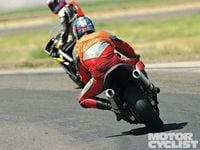One of the primary purposes of training is to help a rider ramp up acceptance of the unknown. Any breakthrough in riding has some physical sensation attached to it. It's the delicious price we pay to approach the unknown.
What did it feel like when you let out the clutch that first time? Nervous but thrilling, right? Take that a step farther and imagine what it would feel like to be a stunt rider doing wheelies and stoppies or a MotoGP racer with his knee on the deck? Improvement begins once the rider can embrace those mysterious limits of riding.
Each barrier is based on the unknown. What will it feel like to go into that corner 2 mph faster; brake that much harder; lean that much further; roll on the gas that extra bit? Breaking through those barriers is the challenge, and on the other side is the confidence all riders desire.
When you see a rider falter, you are witnessing in him the fear of the unknown. You see him flinch. Anticipation of some imagined bad result keeps us from moving forward into that uncharted territory of new sensations. When we flinch, we waver from our purpose to execute the control inputs necessary to achieve the intended result.
Riders say, "I don't go that fast," "I don't trust the tires," "I'm afraid of the lean angle, acceleration, braking forces, quick-flicking the bike," etc. Each of us has our own barriers, and we feel the pressure from them. I call them survival reactions.
We often assume they are real and tend to agree with these barriers, despite the contrary evidence of someone else going cleaner, quicker, smoother, on better lines, passing where we can’t, changing gears more smoothly, riding and braking more confidently, and so on.
Riders have a common fear of locking up the front tire from over-braking. Anyone who hasn't taken himself to the extremes of braking has only a vague idea of how much stopping force can be applied.
Unfortunately, it's not something that you can visualize; you have to get down-and-dirty with the brakes and feel it or you are very likely to panic in a situation that demands hard braking. It's also true that ABS makes this almost irrelevant—almost. Without a feel for maximum braking, it's just as likely that riders will target-fixate onto some obstacle simply because the sensation of that much braking force is unfamiliar.
A fear of either right- or left-hand turns is also common among riders. Their flinch-side will be the side that gets them in trouble when panic kicks in. Overcoming that fear for most riders takes as little as 5 minutes with good coaching. You don’t have to be going warp-speed to handle this; in fact, it is correctable in a parking area provided the coach knows what to look for and how to correct it. The results are great because riders realize how much stress they were under and feel immediate relief once corrected.
But what happens in real life when you have a real corner and are freaking out about running wide at real speed at real lean angles? This is one of the best reasons for racetrack training. With about four lanes of space, you can start to build confidence in leaning the bike over more. Once riders get the feel of it with less fear of running off, they can begin to apply it to their street riding. They’ve been that far over … and done that.
More often than not, the flinch can be overcome once it is identified. No one likes to waver, to give up or feel confused about something. Making leaps of faith into the unknown by hoping the bike will do your biding often finds riders biting off more than they can chew. Training lets you elevate your acceptance of that next level of rider confidence, speed and skill, cut down on the stress and increase your ability to get what you want out of riding. By finding limits and embracing the sensations that go along with them, you can exceed your current ideas of what you can do. MC











/cloudfront-us-east-1.images.arcpublishing.com/octane/ITNLTIU5QZARHO733XP4EBTNVE.jpg)
/cloudfront-us-east-1.images.arcpublishing.com/octane/VZZXJQ6U3FESFPZCBVXKFSUG4A.jpg)
/cloudfront-us-east-1.images.arcpublishing.com/octane/QCZEPHQAMRHZPLHTDJBIJVWL3M.jpg)
/cloudfront-us-east-1.images.arcpublishing.com/octane/HXOUJXQWA5HBHGRO3EMJIGFMVI.jpg)

/cloudfront-us-east-1.images.arcpublishing.com/octane/3TIWWRV4JBBOLDVGRYECVVTA7Y.jpg)
/cloudfront-us-east-1.images.arcpublishing.com/octane/KIX5O23D5NAIBGFXBN3327DKZU.jpg)
/cloudfront-us-east-1.images.arcpublishing.com/octane/7GJYDUIPXRGMTMQKN6ONYOLBOU.jpg)
/cloudfront-us-east-1.images.arcpublishing.com/octane/MUQLOVLL2ZDGFH25ILABNBXKTI.jpg)
/cloudfront-us-east-1.images.arcpublishing.com/octane/TNOU5DNE2BC57MFPMGN2EIDXAM.jpg)
/cloudfront-us-east-1.images.arcpublishing.com/octane/GTCXACQGJ5HAPDTGWUQKDEH44E.jpg)
/cloudfront-us-east-1.images.arcpublishing.com/octane/S35YGSEMEZB4BLTDJTSZPF4GLA.jpg)
/cloudfront-us-east-1.images.arcpublishing.com/octane/5UOT6HPX2JFMRJAX6EH45AR4MQ.jpg)
/cloudfront-us-east-1.images.arcpublishing.com/octane/OKWOJWAKP5EP3OACCRRWPCIX2Q.jpg)
/cloudfront-us-east-1.images.arcpublishing.com/octane/2WF3SCE3NFBQXLDNJM7KMXA45E.jpg)
/cloudfront-us-east-1.images.arcpublishing.com/octane/G4MG6OUCJNBSHIS2MVVOTPX65E.jpg)
/cloudfront-us-east-1.images.arcpublishing.com/octane/IIGGWFOTOJGB7DB6DGBXCCMTDY.jpg)
/cloudfront-us-east-1.images.arcpublishing.com/octane/QSTCM6AVEZA5JJBUXNIQ3DSOF4.jpg)
/cloudfront-us-east-1.images.arcpublishing.com/octane/U4I7G625B5DMLF2DVIJDFZVV6M.jpg)
/cloudfront-us-east-1.images.arcpublishing.com/octane/B6XD6LS6IVCQPIU6HXDJSM3FHY.jpg)
/cloudfront-us-east-1.images.arcpublishing.com/octane/ICL63FEDDRDTTMINYICCEYGMDA.jpg)
/cloudfront-us-east-1.images.arcpublishing.com/octane/FCGZHQXRBZFLBAPC5SDIQLVF4I.jpg)
/cloudfront-us-east-1.images.arcpublishing.com/octane/WNOB6LDOIFFHJKPSVIWDYUGOPM.jpg)
